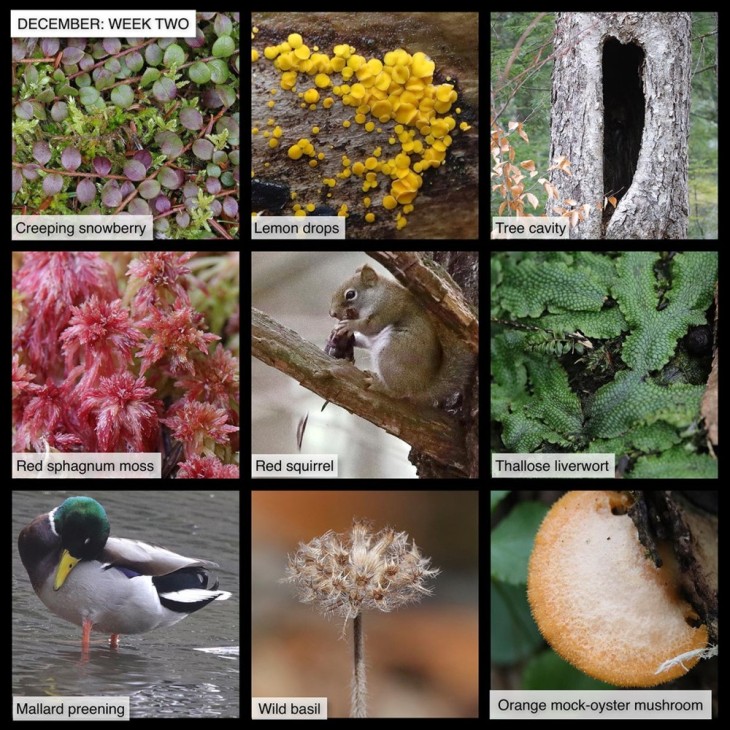This Week in the Woods, we stumbled upon a patch of creeping snowberry. This ground plant’s tiny leaves (each about the size of raindrop) have white hairs widely spaced along the edges. Creeping snowberry is in the same genus as better-known wintergreen, and if you nibble a leaf, you’ll discover that it has the same wintergreen taste. Although it’s an evergreen, in the patch we discovered some sprigs that bore glossy purple leaves. Look for the plant in damp, acidic areas; for example, under conifers on the edge of wetlands. Here’s a profile from Adirondacks Forever Wild. Important note: there is also an unrelated garden plant called snowberry, which is toxic.
Lemon drops aren’t choosy. The small, bright yellow fruiting bodies of these fungi pop up on the dead and dying wood of both hardwoods and conifers, typically in clusters. Here’s a brief YouTube video that shows how a mass can look growing on a log (notice the spider?). Other names for lemon drops include “lemon disco” and “yellow fairy cups.”
Some of the most important trees in the forest, habitat-wise, are the ones with gaping holes and decaying centers. As Tami Gingrich notes in this recent Outside Story article, tree cavities provide summer nurseries and winter lodging for a host of different species. See this guide to wildlife tree management from the Northeastern Forest Experiment Station, including a table on the second page identifying 41 northeastern species that use tree cavities, and providing recommendations for foresters and landowners who seek to promote “wildlife trees” in forest management plans.
Back in November, we wrote about sphagnum moss, including the fun fact that a bog in Ireland preserved a large chunk of butter for over 2,000 years. What we didn’t note is that, while most species in the Northeast are green, there are also partial-to-all red sphagnum species. The moss in the photo is probably Sphagnum capillifolium, which according to the Princeton Field Guides’ Common Mosses of the Northeast and Appalachians, has a dome-like growth form, and tends to grow in especially acidic, nutrient-poor environments.
If you pass through a stand of conifers, chances are one or more red squirrels will shriek at you from the branches and/or rain cone bracts on your head. These small squirrels – so much feistier than their bigger gray cousins – are feeding on pine and spruce seeds and stockpiling unopened cones for later consumption. As Meghan McCarthy McPhaul notes in this Outside Story essay, the interior layers of squirrel middens (cone mounds) maintain cool, moist conditions that prevent cones from opening, and therefore keep seeds from scattering before red squirrels can consume them. A red squirrel may collect over 15,000 cones in a single autumn.
If you are walking along a forest stream, keep an eye out for bright green thallose liverworts. These are ancient, flat-growing plants that often resemble reptile skin (the plant in the photo is probably a common species, snakeskin liverwort). Thallose liverworts may grow as several cell-thick sheets, with photosynthetic cells at the surface, and gripping (root-like) cells underneath. Some can reproduce in multiple ways: by spores, fragmentation and gemmae cups – groups of cells that are dislodged by water. Here’s an Outside Story about liverworts by Susan Shea, who notes that liverworts have been around a very long time: “Fossilized spores from five different types of liverworts dating from about 472 million years ago were found in rocks in Argentina in 2010.” And here’s a YouTube video on liverwort reproduction (a bit dry, but to the point, and the British accent helps).
Why is this mallard drake holding his head backwards? He’s preening. Ducks and most other birds have an uropygial (preening) gland above the tail, which produces an oil they use for grooming. This mallard is spreading the oil with his beak (and rubbing his head in freshly coated feathers) as a means of maintaining waterproof plumage. Here’s an excellent short video from the KQED San Francisco “Deep Look” science series, showing the tiny water-proofing structures in feathers, and explaining how preening maintains them: “Every time a duck runs its bill down a feather, it zips its barbs back together again.”
Wild basil is a small wildflower that’s common in fields and other man-made sites (its origins are a bit confusing – apparently it was native to some areas, introduced from European stock in others). A member of the mint family, it’s beloved by bees, and its leaves are sometimes used for teas. By November, the flowers and leaves are long gone, but its furry stems and seed heads are still pretty, up close. Here’s a profile from the Lady Bird Johnson Wildflower Center.
Mild November weather extended the fungal growing season, and it’s still possible to find a variety of soft-bodied mushrooms – albeit now frozen – attached to old logs. We found a group of orange mock-oyster mushrooms clustered in a protected spot. These late-summer-through-late-fall mushrooms are notable for the fuzziness of their caps and their orange gills. Although you won’t notice when they’re frozen, they also have an unpleasant odor. Here’s a profile from mushroomexpert.com.
Our thanks to The Frank and Brinna Sands Foundation for helping to support this series.
In this difficult period, many of us find joy in observing local nature, and many families are seeking outdoor enrichment opportunities for children. Here are nine photographs taken this past week, most within 15 miles of the Northern Woodlands office in Lyme, New Hampshire. We hope you enjoy using this grid as a prompt for your own explorations, or as the basis for a game of family forest tic-tac-toe.
What are you seeing in the woods this week? Share your images with us on Facebook, or submit a special photo for possible inclusion in our monthly online Reader Photo Gallery.



Discussion *